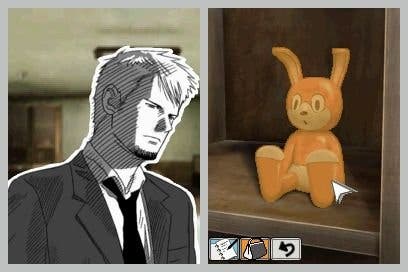Last Window: The Secret of Cape West
No pane, no gain.
Selecting the briefcase option allows you to access your inventory which contains keys to locked rooms, your work pager and any useful items you collect in the course of the adventure. More complexity is added here with the option to combine items in the LucasArts style, as well as compare specific items with one another as per Phoenix Wright. Finally, in keeping with the eighties aesthetic, your ring-bound Filofax contains character profiles of people you've met, useful notes (such as safe lock and key combinations and other important names and numbers) and a useful summary of chapters you have completed thus far.
Additionally, as you complete sections of the game, you unlock new chapters of a digital novel, rather confusingly titled Last Window: The Secret of Cape West. Presented in the style of an iBook, this concurrent story offers its own narrative, and clues uncovered here can be useful in the game itself. It's an awkward, peculiarly Japanese way of nesting stories together, but approached with an open mind, it adds to the package.
The art style of the game is so closely entwined with its systems that it's difficult to describe one without the other. Conversations are where CiNG's directorial flair is best shown off. As Hyde quizzes people, a scratchy, hand-drawn pencil image of his actions and reactions plays out on the left hand screen, while those of his interviewee play out on the right. Colour seeps into the images when a new character is introduced, or when a crucial piece of information is imparted, while the animations behind each drawing are fluid and natural. Conversation options are limited, with just a few different threads to pursue in any particular line of questioning, but this economy allows the developer to ramp up the visual flourishes, and the result is one of the most arresting presentations of a story seen in the medium.

The translation is solid, but fails to match the style of the visuals. Hyde's internal monologue plays out constantly, something useful during conversations, to clarify what he is thinking at any given point, but superfluous elsewhere. The storyteller's maxim 'show, don't tell' is struck through; Last Window instead shows and tells at every point, bloating every scene.
Stretched over a week, rather than the single day of Hotel Dusk, Last Window's pacing can often feel off-kilter. There are long stretches of downtime, during which Hyde will, for example, visit the movies instead of pursuing his goals just to fill the game's timeframe. As a result there are long stretches without plot development, usually followed by a cascade of information and leads; realistic, perhaps, but disconcerting and uneven in this context.
Last Window's unique marriage of art, story and game feels at once contemporary and anachronistic. Pitched to the Professor Layton crowd, its ponderous pacing and obscure puzzles will seem laborious, too much work for too little payoff. For those hankering after a modern take on Broken Sword, the emphasis on dialogue and ambiance will feel as though substance has been traded for style. As such, the game is best viewed as a curio quite unlike anything else, an experience that deserves its niche off gaming's highway, and whose mild shortcomings are made up for by a combination of uniqueness and general competence.
Last Window: The Secret of Cape West is released 17th September exclusively for DS.
